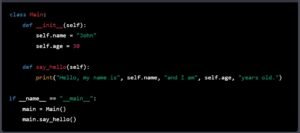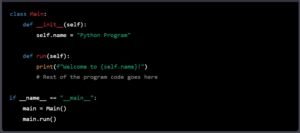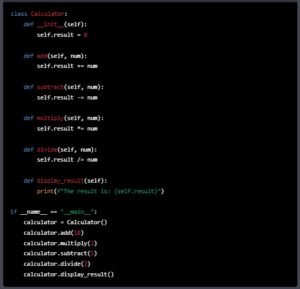
Main Class in Python | CBSE – Class 12
Python Main Classes
Introduction
Python is a popular and versatile programming language that is widely used for a variety of applications, including web development, data analysis, and machine learning.
One of the key features of Python is its object-oriented programming (OOP) capabilities. In Python, classes are an essential part of OOP, and they provide a way to define objects and their properties.
Main classes, in particular, are an important type of class in Python, as they serve as the entry point to your program.
In this blog post, we’ll explore what Python main classes are, how to create them, and the benefits of using them in your code.
Whether you’re new to Python or a seasoned developer, understanding main classes is essential for building robust and scalable applications.
By the end of this post, you’ll have a solid understanding of how main classes work in Python and how to use them effectively in your own projects.
importance of Main classes in Python for a few key reasons.
Main classes are important because they provide a structure for organizing the code in a Python program.
First, they provide a clear starting point for your program, making it easier to understand and maintain. By defining a main class, you can structure your code in a way that is logical and intuitive, making it easier for others to understand and modify your code.
Second, main classes allow you to define and manage your program’s overall structure and functionality. By encapsulating the main functionality of your program within a single class, you can more easily control and manage the behavior of your program as a whole.
Third, main classes provide a way to separate your code into logical components. By breaking your code up into smaller, more manageable classes, you can make your code more modular and reusable, which can save you time and effort in the long run.
In addition, main classes can be used to create reusable code that can be shared across multiple programs. For example, if you have a class that handles file input and output, you can use that class in multiple programs without having to rewrite the code each time.
By separating the code into classes, it becomes easier to manage and maintain. Each class can be responsible for a specific aspect of the program’s functionality, making it easier to add new features or fix bugs without affecting the rest of the program.
What is a main class?
A main class is in Python.
In Python, a main class is a special type of class that serves as the entry point to your program. It’s the starting point from which your program executes, and it typically contains the code that is executed when you run your Python script. The main class is usually defined in a separate module or file, and it’s typically named “main” or “Main” (although the naming convention is not strict).
The main class in Python is similar to the main() function in other programming languages, such as C and Java. It’s the code that is executed when your program is run, and it typically calls other functions and methods to perform specific tasks. By convention, the main class in Python is defined in a file that has the same name as the module, with the extension .py.
How a main class is differs from other classes in Python.
In Python, a main class is not fundamentally different from any other class. It is simply a convention to have a specific class in a program that serves as the entry point for the program.
However, there are some practical differences between a main class and other classes in Python. Here are a few:
- Execution: A main class is typically executed when a Python program is run. It contains the code that is executed first and sets up the rest of the program. Other classes may be used in the program, but they are not necessarily executed when the program is run.
- Organization: A main class is often used to organize the code in a Python program. It may contain other classes and functions that are used throughout the program. Other classes may be organized in different ways, depending on their purpose and relationship to other parts of the program.
- Naming conventions: In some programming languages, such as Java, a main class must be named a specific way (e.g. “Main” or “Program”). In Python, there is no strict naming convention for main classes, but it is common to use a name like “Main” or “App” to indicate its purpose.
- Inheritance: A main class can inherit from other classes, just like any other class in Python. This allows it to inherit properties and methods from other classes, which can be useful for organizing and reusing code.
An example of a main class in Python.
Here’s an example of a main class in Python:

In this example, we define a main class called Main. The class has an __init__ method that initializes two instance variables, name and age. We also define a method called say_hello that prints a message to the console using the instance variables.
At the bottom of the file, we check if the current file is being run as the main program using the if __name__ == "__main__": statement. If it is, we create an instance of the Main class and call its say_hello method.
When we run this script, the output will be:

This example demonstrates how the main class serves as the entry point to the program, and how it can be used to define and execute the main functionality of your Python code.
How to create a main class
The steps required to create a main class in Python.
Here are the steps required to create a main class in Python:
- Define the main class: The first step in creating a main class is to define the class itself. You can do this using the
classkeyword, followed by the name of the class and any parent classes it may inherit from.
- Define the
__init__method: The__init__method is a special method that gets called when an instance of the class is created. It is used to set up any instance variables that the class will use. In the case of a main class, you might use the__init__method to set any initial state or configuration values.
- Define other methods as needed: In addition to the
__init__method, you may want to define other methods that the main class will use. These could include methods for running the program, handling user input, or performing other actions.
- Use the
if __name__ == "__main__":block: To create a main class in Python, you need to use theif __name__ == "__main__":block. This block is used to determine whether the file is being run as the main module or being imported as a module in another file. If the file is being run as the main module, you can create an instance of the main class and call its methods to run the program.
Here’s an example of how these steps might look in practice:

In this example, the main class is defined with an __init__ method that sets the name of the program and a run method that contains the code that should be executed when the program is run. The if __name__ == "__main__": block is used to check if the program is being run as the main module, and an instance of the Main class is created and its run method is called.
By following these steps, you can create a main class in Python that serves as the entry point for your program and helps organize your code in a clear and reusable way.
An example of creating a main class in Python.
Here’s an example of creating a main class in Python:

In this example, we’ve created a Calculator class that has four methods for performing basic mathematical operations, as well as a display_result method for printing the result to the console. In the __init__ method, we’ve initialized the result variable to zero.
At the bottom of the code, we’re using the if __name__ == "__main__": block to create an instance of the Calculator class, perform a series of operations on it, and then display the result.
When we run this code, we’ll see the following output:

his example demonstrates how you can use a main class in Python to create a program that performs a specific task (in this case, basic math operations). By organizing your code into a main class and other supporting classes and functions, you can make your code more modular and easier to maintain and reuse.
Benefits of using a main class
Advantages of using a main class in Python.
There are several advantages to using a main class in Python:
- Better organization of code: A main class can help you organize your code more effectively by providing a clear entry point for your program and encapsulating related functionality in a single class. This can make your code easier to understand and maintain, especially as it grows more complex.
- Improved readability: By encapsulating the main logic of your program in a main class, you can make your code more readable and easier to follow. This can be especially helpful for team projects or large codebases where multiple developers may need to work on the same code.
- Easier testing and debugging: Because a main class encapsulates the main logic of your program, it can make testing and debugging easier. By isolating the main logic from other code, you can more easily identify and fix errors when they occur.
- Reusability: A main class can be used to create a reusable module that can be imported and used in other projects. This can save time and effort by allowing you to reuse code that you’ve already written, rather than starting from scratch for each new project.
- Separation of concerns: By separating the main logic of your program from other code, a main class can help you ensure that each component of your program is responsible for a specific set of tasks. This can make it easier to maintain and update your code over time, as you can make changes to one component without affecting others.
Overall, using a main class in Python can help you write more organized, readable, and maintainable code, while also improving the testing and debugging process and promoting code reuse.
How main class can make your code more organized and easier to maintain.
Using a main class in Python can make your code more organized and easier to maintain in several ways:
- Modular design: By encapsulating the main functionality of your program within a main class, you can separate it from other code, making it easier to manage and maintain. This modular design approach can also make it easier to test and debug your code.
- Clear separation of concerns: A main class can provide a clear separation of concerns, allowing you to break down your code into smaller, more manageable pieces. This can make it easier to understand the purpose of each component and how they work together to achieve the overall functionality of your program.
- Code reuse: A main class can be designed to be reusable, allowing you to import and use it in other projects. This can save time and effort by enabling you to reuse code that you have already written, rather than starting from scratch for each new project.
- Encapsulation of data and behavior: By encapsulating data and behavior within a main class, you can limit the access to and manipulation of data and functions to only the necessary parts of the program. This can help you avoid bugs and errors that might occur when data is manipulated by unintended parts of the code.
- Easier debugging: If you have an error in your code, using a main class can help you pinpoint where the problem lies more easily. By isolating the main logic from other parts of the code, you can more easily identify and fix errors when they occur.
In summary, using a main class in Python can help you write more organized, modular, and maintainable code by providing a clear separation of concerns, enabling code reuse, encapsulating data and behavior, and making debugging easier.
Best practices for using main classes in Python
Tips for how to use main classes effectively in Python.
Here are some tips for using main classes effectively in Python:
- Plan ahead: Before you start coding, take the time to plan out the structure of your program and how you will use a main class to encapsulate the main logic. This can help you avoid costly design mistakes and ensure that your code is organized and maintainable from the start.
- Use descriptive class and method names: To make your code more readable and easier to understand, use descriptive class and method names that accurately describe the functionality they provide. This can also help other developers understand your code more easily if they need to work on it in the future.
- Keep main classes small and focused: A main class should encapsulate the main logic of your program, but it should also be small and focused. Don’t try to put everything in one class – instead, break down your code into smaller, more manageable pieces that can be easily understood and maintained.
- Use inheritance and polymorphism: Inheritance and polymorphism can be powerful tools for creating more modular and maintainable code. By using inheritance, you can create subclasses that inherit the functionality of the main class while also adding their own unique functionality. Polymorphism can be used to ensure that each subclass provides a consistent interface, making it easier to work with and understand.
- Test your code thoroughly: Testing is critical to ensuring that your code works as intended and is free from bugs and errors. When using main classes, it is especially important to test your code thoroughly to ensure that each component works as intended and that there are no unexpected interactions between different parts of your code.
By following these tips, you can use main classes effectively in Python to create more organized, modular, and maintainable code that is easier to understand, test, and debug.
Common mistakes to avoid when using main classes.
Here are some common mistakes to avoid when using main classes in Python:
- Overcomplicating the main class: One common mistake is to put too much functionality into the main class. This can make the class hard to understand and maintain. Instead, you should aim to keep the main class focused on its primary purpose, and move any additional functionality into separate classes.
- Not encapsulating data and behavior: Encapsulation is a key benefit of using a main class. If you don’t properly encapsulate data and behavior, other parts of the program can directly modify or access data, which can lead to errors and bugs. You should aim to keep data and behavior hidden within the main class and provide only the necessary methods to manipulate or access that data.
- Not planning ahead: Before starting to write code, it’s important to plan ahead and think about how to use a main class to encapsulate the main logic. Failure to plan ahead can result in code that is difficult to maintain or modify later.
- Not using inheritance or polymorphism: Inheritance and polymorphism are powerful tools for creating more modular and maintainable code. Failure to use these features can result in code that is unnecessarily complex or difficult to understand.
- Not testing the code properly: Testing is essential to ensure that your code works as expected. Not testing the code properly can lead to bugs and errors that are difficult to identify and fix later on.
In summary, to avoid common mistakes when using main classes in Python, you should keep the main class focused and not overcomplicate it, properly encapsulate data and behavior, plan ahead, use inheritance and polymorphism where appropriate, and thoroughly test the code to ensure it works as intended.
Conclusion
Key points Summary the of the main class in python.
The blog post discussed the concept of Python main classes, which are classes that encapsulate the main logic of a program. The main class serves as a central point of control for the program and can make code more organized and easier to maintain. The post provided an example of a main class and explained the steps required to create one. It also discussed the advantages of using a main class in Python, such as increased modularity and easier debugging. Finally, the post provided tips for using main classes effectively in Python, such as planning ahead, using descriptive class and method names, keeping main classes small and focused, using inheritance and polymorphism, and testing code thoroughly.
Start using main classes in your own Python code.
If you’re a Python developer, I highly encourage you to start using main classes in your own code. Main classes can help you create more organized, modular, and maintainable code, making it easier to understand and debug your programs. By encapsulating the main logic of your program in a main class, you can also make your code more reusable and easier to modify or extend in the future.
While there may be a learning curve when it comes to using main classes effectively, the benefits are well worth it. With practice and experience, you can become more comfortable using main classes and begin to reap the benefits of cleaner, more modular code.
So, if you haven’t already, give main classes a try in your next Python project. Start small, experiment with different techniques, and don’t be afraid to ask for help or seek out resources if you need them. With time and practice, you’ll be able to create more organized, maintainable, and effective code that you can be proud of.
—————————————————————————————————————————
Are you a student of CBSE Board ?
Learn Computer Science with Python Visit Our Blog


